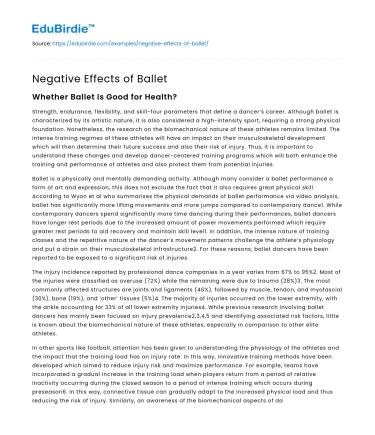Whether Ballet Is Good for Health?
Strength, endurance, flexibility, and skill-four parameters that define a dancer’s career. Although ballet is characterized by its artistic nature, it is also considered a high-intensity sport, requiring a strong physical foundation. Nonetheless, the research on the biomechanical nature of these athletes remains limited. The intense training regimes of these athletes will have an impact on their musculoskeletal development which will then determine their future success and also their risk of injury. Thus, it is important to understand these changes and develop dancer-centered training programs which will both enhance the training and performance of athletes and also protect them from potential injuries.
Ballet is a physically and mentally demanding activity. Although many consider a ballet performance a form of art and expression, this does not exclude the fact that it also requires great physical skill. According to Wyon et al who summarises the physical demands of ballet performance via video analysis, ballet has significantly more lifting movements and more jumps compared to contemporary dance1. While contemporary dancers spend significantly more time dancing during their performances, ballet dancers have longer rest periods due to the increased amount of power movements performed which require greater rest periods to aid recovery and maintain skill level1. In addition, the intense nature of training classes and the repetitive nature of the dancer’s movement patterns challenge the athlete’s physiology and put a strain on their musculoskeletal infrastructure2. For these reasons, ballet dancers have been reported to be exposed to a significant risk of injuries.
Save your time!
We can take care of your essay
- Proper editing and formatting
- Free revision, title page, and bibliography
- Flexible prices and money-back guarantee
The injury incidence reported by professional dance companies in a year varies from 67% to 95%2. Most of the injuries were classified as overuse (72%) while the remaining were due to trauma (28%)3. The most commonly affected structures are joints and ligaments (46%), followed by muscle, tendon, and myofascial (30%), bone (19%), and ‘other’ tissues (5%)4. The majority of injuries occurred on the lower extremity, with the ankle accounting for 33% of all lower extremity injuries4. While previous research involving ballet dancers has mainly been focused on injury prevalence2,3,4,5 and identifying associated risk factors, little is known about the biomechanical nature of these athletes, especially in comparison to other elite athletes.
In other sports like football, attention has been given to understanding the physiology of the athletes and the impact that the training load has on injury rate. In this way, innovative training methods have been developed which aimed to reduce injury risk and maximize performance. For example, teams have incorporated a gradual increase in the training load when players return from a period of relative inactivity occurring during the closed season to a period of intense training which occurs during preseason6. In this way, connective tissue can gradually adapt to the increased physical load and thus reducing the risk of injury. Similarly, an awareness of the biomechanical aspects of dancers will be beneficial for them as it will allow them to improve their current training techniques, employ effective injury prevention strategies, and also to establish better physical conditioning.






 Stuck on your essay?
Stuck on your essay?

